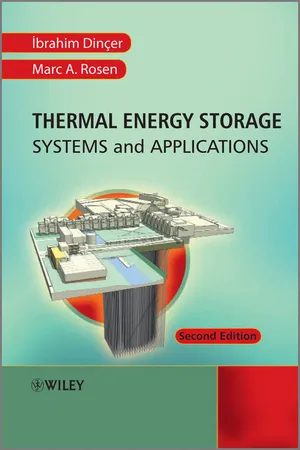
- English
- ePUB (mobile friendly)
- Available on iOS & Android
About this book
The ability of thermal energy storage (TES) systems to facilitate energy savings, renewable energy use and reduce environmental impact has led to a recent resurgence in their interest. The second edition of this book offers up-to-date coverage of recent energy efficient and sustainable technological methods and solutions, covering analysis, design and performance improvement as well as life-cycle costing and assessment. As well as having significantly revised the book for use as a graduate text, the authors address real-life technical and operational problems, enabling the reader to gain an understanding of the fundamental principles and practical applications of thermal energy storage technology.
Beginning with a general summary of thermodynamics, fluid mechanics and heat transfer, this book goes on to discuss practical applications with chapters that include TES systems, environmental impact, energy savings, energy and exergy analyses, numerical modeling and simulation, case studies and new techniques and performance assessment methods.
Frequently asked questions
- Essential is ideal for learners and professionals who enjoy exploring a wide range of subjects. Access the Essential Library with 800,000+ trusted titles and best-sellers across business, personal growth, and the humanities. Includes unlimited reading time and Standard Read Aloud voice.
- Complete: Perfect for advanced learners and researchers needing full, unrestricted access. Unlock 1.4M+ books across hundreds of subjects, including academic and specialized titles. The Complete Plan also includes advanced features like Premium Read Aloud and Research Assistant.
Please note we cannot support devices running on iOS 13 and Android 7 or earlier. Learn more about using the app.
Information

Table of contents
- Cover
- Title Page
- Copyright
- Dedication
- About the Authors
- Preface
- Acknowledgements
- 1 General Introductory Aspects for Thermal Engineering
- 2 Energy Storage Systems
- 3 Thermal Energy Storage (TES) Methods
- 4 Thermal Energy Storage and Environmental Impact
- 5 Thermal Energy Storage and Energy Savings
- 6 Energy and Exergy Analyses of Thermal Energy Storage Systems
- 7 Numerical Modeling and Simulation of Thermal Energy Storage Systems
- 8 Thermal Energy Storage Case Studies
- 9 Recent Advances in TES Methods, Technologies, and Applications
- Appendix A Conversion Factors
- Appendix B Thermophysical Properties
- Appendix C Glossary
- Index